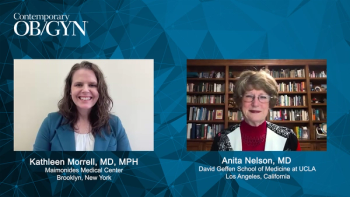Kathleen Morrell, MD, MPH
Articles by Kathleen Morrell, MD, MPH

Panelists discuss how the "if it's not broken, don't fix it" approach guides contraceptive continuation decisions, emphasizing the importance of directing patients to reliable online resources such as Bedsider.org to combat misinformation and support informed decision-making.

Panelists discuss how breakthrough bleeding affects approximately 20% of users initially but improves over time and can be managed through patient education about expectations, nonsteroidal anti-inflammatory drugs (NSAIDs) for acute episodes, and adjustments to estrogen dose or progestin type when necessary.

Panelists discuss how shortened hormone-free intervals (24-4 and 24-2-2 regimens) prevent ovarian reactivation and endometrial proliferation that caused breakthrough bleeding with traditional 21/7 formulations, while addressing how amenorrhea can be viewed as either a desired therapeutic outcome or concerning adverse effect depending on patient preferences.

Panelists discuss how misconceptions about lower efficacy and increased drug interactions persist with low-dose estrogen pills, while adverse effects such as headaches and nausea are managed through anticipatory guidance and proper counseling without creating unnecessary anxiety.

Panelists discuss how the drospirenone/estetrol (E4) pill with 14.2 mg of estrogen provides effective contraception with a long half-life progestin that accommodates typical user behavior, while explaining that milligram vs microgram dosing reflects different estrogen metabolism rather than higher exposure.

Panelists discuss how the norethindrone acetate/ethinyl estradiol pill with 10 mcg of estrogen became the best-selling branded pill in the US due to its effective 24/2/2 formulation that minimizes bleeding issues through reduced placebo days and low-dose estrogen support.

Panelists discuss how estrogen dosing selection depends on individual patient factors, including cycle control needs, noncontraceptive goals, estrogen sensitivity, age considerations for bone health, and patient comfort with hormone levels, with most providers using lower doses primarily to address estrogen-related adverse effects.

Panelists discuss how ideal candidates for combined hormonal contraceptives are those medically cleared for estrogen use who prefer predictable monthly periods, while progestin-only methods are recommended for patients with estrogen contraindications such as elevated body mass index (BMI) combined with older age or hypertension with migraines.

Panelists discuss how progestins have evolved from early norethindrone compounds through more potent but androgenic levonorgestrel to newer options such as drospirenone and dienogest, each offering different benefits for cycle control, noncontraceptive effects, and adverse effect profiles.

Panelists discuss how most combined hormonal contraceptives contain ethinyl estradiol for its long half-life and cycle control benefits, while newer natural estrogens such as estradiol and estetrol offer different tissue selectivity and potentially reduced liver impacts.

Panelists discuss how younger women (18-24) most commonly use condoms and oral contraceptive pills due to factors like less frequent sex, dual protection needs, and access issues, while emphasizing that individual preferences matter more than age when counseling patients.

Panelists discuss how combined hormonal contraceptives come in three main forms (pills, patches, and rings) and provide a comprehensive overview of all available contraceptive methods including long-acting reversible contraceptives, barrier methods, and emergency contraception.

